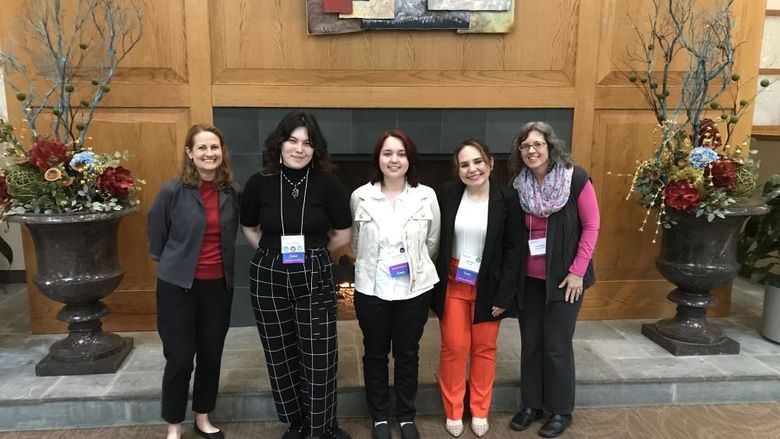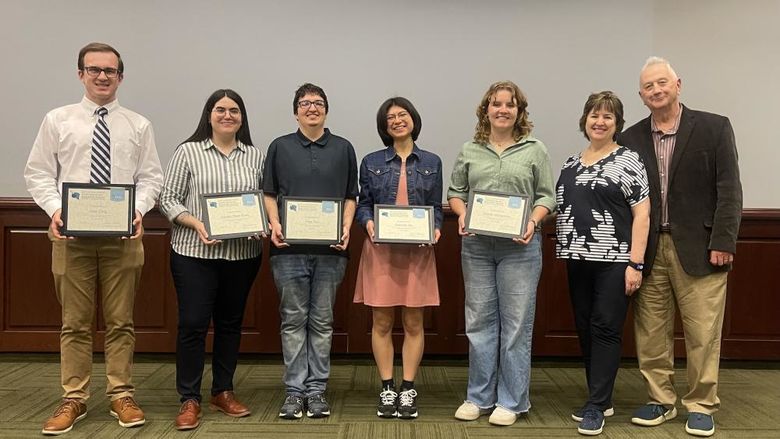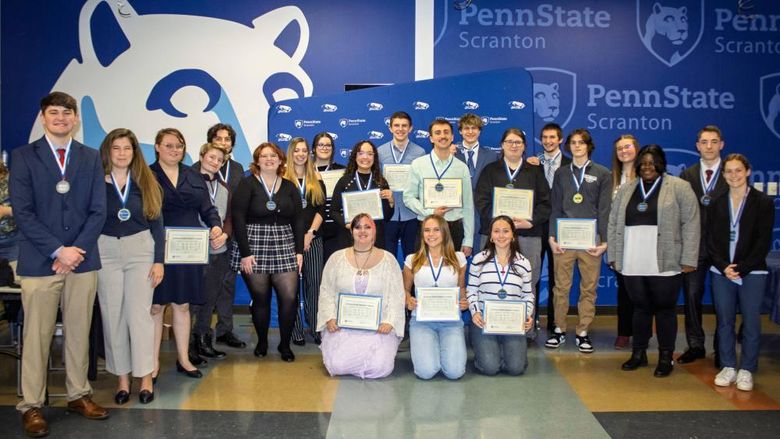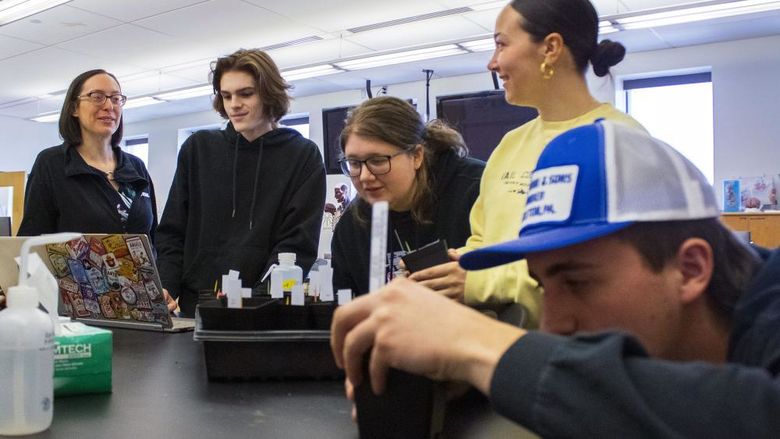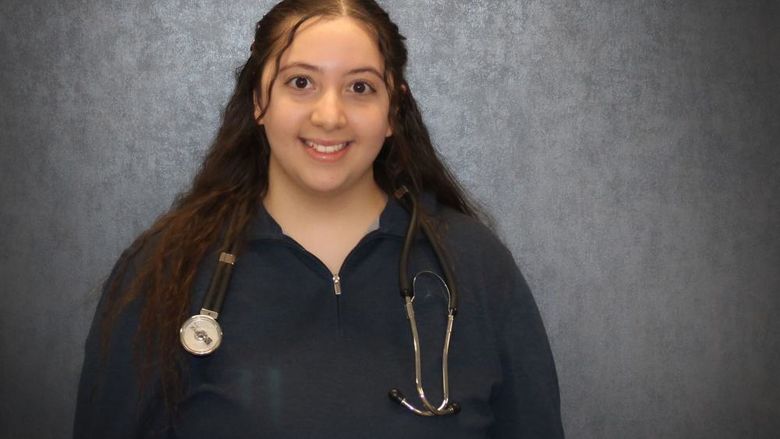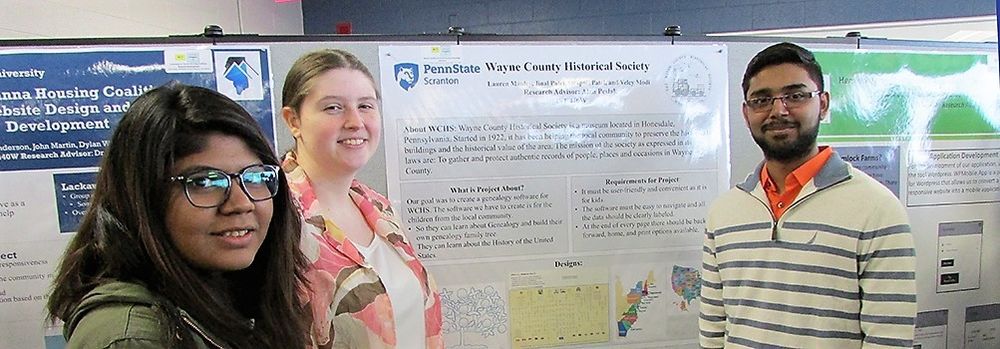
Students at Penn State Scranton will have the opportunity this year to showcase their undergraduate research projects in person, as these students from the 2019 Undergraduate Research Fair and Exhibition did. There are 112 students scheduled to present their work this year, and those planning the event are excited to have it back on campus.
DUNMORE, Pa. — This year, for the first time in three years, Penn State Scranton's Undergraduate Research Fair and Exhibition will be taking place in person, after having been held virtually due to the Covid-19 pandemic.
Scheduled for Wednesday, April 6, this year's event will feature the work of 112 students presenting their scholarly research and creative works through oral presentations, poster displays, gallery exhibits and artistic performances.
Megan Van Etten, this year’s Undergraduate Research Fair and Exhibition coordinator, noted that with four different types of projects, each with their own presentation styles and requirements, planning is always a complicated team effort.
“Planning has been a bit chaotic, since it has been so long since we were able to have an in-person fair.” she said. “Luckily, we have the help of the wonderful Suzanne Morgan and Shannon Williams. They do almost all of the hard behind-the-scenes work.”
In addition to the work of Morgan and Williams, there is also a lot of effort undertaken by the fair's sub-committee, with heavy dependence on additional faculty and staff to judge the projects. “We also have multiple students helping to organize the event as well as speak during the event,” said Van Etten.
Although the virtual fair had its advantages, which were discovered as a result of the COVID-19 pandemic, Morgan said she is glad to be back in-person. Morgan explained that one advantage to a virtual presence, is that individuals who cannot attend the in-person event, particularly family members, can view projects online and in more detail.
“But an in-person event is dynamic; and seeing how proud the students are of their research, presentations, artwork and creative work can only be witnessed in-person. It is rewarding to see the presenters’ enthusiasm for their work and their excitement to be part of an in-person fair and exhibition,” she said.
“This year’s event will be similar to the previous in-person event; we will again have oral presentations, reading of creative works, an exhibition of art pieces and poster presentations,” Van Etten explained.
“I think the entire committee is ecstatic about being able to connect more personally with our students this year," added Van Etten. "The virtual format of the previous years held some advantages, but in-person interactions lead to more dynamic and involved discussions, which is a main goal of the research fair and exhibition."
Morgan mentioned that the only thing that is different from the past is that even though it is an in-person event, this is the first year the campus will still have the web showcase of fair projects, with the online showcase for viewing only; there will be no Zoom component.
Van Etten mentioned that the committee decided to add a webpage to display information about each project and the posters so that a broader audience can appreciate the students’ work. “We also added a judged category for artwork this year,” she noted.
“Also new is a separate period scheduled for reading of written creative works, such as poems, fictional narratives, etc.,” said Morgan.
Morgan commended the student presenters for the amount of time, commitment and hard work they put into their projects and the fair.
“I hope through that journey they unearth their strengths, surprise themselves with new discoveries and talents, and gain confidence in their abilities and to present their work at future conferences and exhibitions,” said Morgan. “I also hope the students just have fun being part of the fair.”
Morgan has been helping to organize the fair since she started at Penn State Scranton and noted “year after year I am always amazed at the terrific work our students are doing and how excited they are to share their accomplishments."
Another important aspect of the fair is that it serves not only as a showcase for students’ work, but also allows students to participate in building new knowledge.
“As academics, we participate in similar events in our own fields,” said Van Etten. “Our goal is to help students understand that they can contribute to the process of better understanding the world we live in.”
Planning begins at the start of the spring semester — with IT playing a major role
Planning for the Undergraduate Research Fair typically begins in January under the direction of the Undergraduate Research Faculty Committee and Penn State Scranton’s IT Department plays a crucial role in preparing for the event, whether it is in person or virtual.
Director of Information Technology Marilee Mulvey, who also serves as an adjunct instructor in Information Sciences and Technology at Penn State Scranton, detailed some of the work that is done by her department. "For the in-person fair, we tune up the poster printers and laminator, and make sure we have enough supplies to print all the posters,” she explained. "Each year the number grows, which is awesome!”
For the virtual event, and resulting Undergraduate Research Fair and Exhibition website, which started in 2020, IT had to change a few processes for obtaining the digital files. “The resulting website is a great way to showcase past and present projects,” said Mulvey, adding that “the IT staff are always excited to see the posters and presentations as they come hot off the presses!”
Mulvey mentioned that Penn State Scranton’s web designer, Shannon Williams, is an integral part of the Undergraduate Research committee. “She makes sure the registration forms contain the information faculty need for judging and that the students have the resources and information they need to create their posters,” said Mulvey, adding that templates are also provided for the students if they'd like to use them. “She also creates the virtual online showcase of posters and projects,” Mulvey commented about Williams.
Mulvey emphasized that IT does whatever is needed to support the students and faculty so that the students' work is showcased in the best way possible, and everything goes smoothly the night of the fair.
“In the information technology world, we are often required to research a new technology that the organization might be looking to acquire,” noted Mulvey. The process of selecting a topic to research, evaluating various publications and articles, and then condensing that into a poster format, is good practice for real-world situations. “Then there's the night of the fair when the students present the information they've learned, which also helps to build confidence and experience in talking with others about technology,” said Mulvey. “It's a challenging project for many students, and it's my hope that the experience prepares them for the types of tasks they might encounter in the working world.”
Mulvey mentioned that it does take quite a few weeks of the semester to work through all the components of the assignment.
“The students work through at least three to four drafts of their posters, and it is rewarding to see how much the posters improve through those drafts,” said Mulvey. “I hope the students feel as good about that as I do! I'm always so proud to see the work they've done and what they've learned through the process. I've also been rewarded with the smiles of my students and their parents when their son or daughter earns a prize at the fair. It's probably my favorite academic event of the year.”
Artistic works are now another main component of the event
Corianne Thompson, lecturer in art at Penn State Scranton, will be overseeing the art exhibition piece of this year's fair — her fourth time doing so. Although COVID-19 altered the exhibits in 2020 and 2021, Thompson supervised her first in-person exhibit in the spring of 2019, and said she is excited that the fair is finally back in-person.
“All of the artwork is new because it has been created by students in the Fall 2021 semester and some from this Spring 2022 semester,” Thompson added.
Out of the total 112 undergraduate students participating in this year’s fair, 60 of them will have their work on display for the art exhibition, which will include drawings, paintings, ceramics and sculptures.
“Anytime you get the chance to see artwork in person, I think it is special and exciting,” said Thompson.
From the details of the brushstrokes in a painting, to the nuances of color change in a colored pencil drawing, or to the craftsmanship of a sculpture, Thompson said she hopes everyone who is able to come to see the exhibit takes some time to slow down and admire the art.
Attendees can look forward to seeing some work that showcases the talents of Penn State Scranton students. Thompson noted, “In addition, this year we have the visual arts portion of the Undergraduate Research Fair being judged, so I wish all of the students who are participating in that portion of the fair best of luck!” She added, “I am so proud of the effort students have been putting into their art, and now the rest of the campus and community will get the chance to see the results of their hard work!”
Kara Stone, assistant teaching professor in English, is co-hosting the oral presentations, alongside Kelley Wagers, associate professor in English. And like many other faculty, staff and students at Penn State Scranton, both Stone and Wagers said they are thrilled that the Undergraduate Research Fair is taking place in person again. Even though Stone enjoyed the fair virtually too, she said, “I am excited to see everyone come together on campus to support undergraduate research.”
“The Zoom sessions last year were fantastic," Wagers said, "but there’s a special energy that happens when we come together in a room to share scholarship and creative writing. I think everyone who attends any part of the fair will find that despite all the challenges our students faced over the last year, they have been doing innovative, valuable work in every discipline.”
The oral presentation sessions typically last about an hour, outlining their research project, where the audience is invited to ask questions or comment on the presentations. “Students who present and/or attend the sessions will learn how to participate in a scholarly conversation that focuses on their work,” said Stone. “For many students, this is the first opportunity for them to do this on campus and hopefully it will lead to further opportunities.”
In addition to the oral presentations, there will again be a separate event for students to share their creative writing. “They’ll read poetry and creative nonfiction this year, which is new because we’ve had more fiction in past exhibitions of creative writing,” Wagers explained.
Anyone can attend both events on April 6: the creative readings will be from 12:15 p.m. to 1:15 p.m. in SLC 32 and the oral panels from 4 to 5:15 p.m. in SLC 33 and SLC 36. “After that, they can go see all the posters!” Wagers added.
“You can expect to hear from Penn State’s talented students,” said Stone. “The best part of these presentations is that the campus gets to see a glimpse of the critical thinking and analysis that goes into being an undergraduate student patriating in research.” And like many others, Stone is excited to be back to the traditional, in-person format.
The University Libraries provide funding annually for the Undergraduate Research Award for Excellence in Information Literacy which can be found here. For this award, specifically, at Penn State Scranton, traditionally the campus librarians Jennie Knies, head librarian for the Scranton and Nesbitt (Penn State Wilkes-Barre) libraries and co-director of the Commonwealth Campus Libraries, along with Kristin Green, Scranton's reference and instruction librarian do the judging. This year, Cameron Nielsen, reference and instruction librarian at Penn State Wilkes-Barre, will also be assisting Knies and Green.
“I love to learn new things and I always learn something new at the research fairs ever year,” mentioned Knies. “For me, the most fun is being able to interact with the students and to see their faces light up when they talk about their research."
This year’s judges are looking specifically for people who have done rigorous research, preferably but not necessarily using resources from the University Libraries. “We want to see evidence of how students conducted their research, learn about their search strategies and see evidence that the sources that they used to support their research are credible,” Knies explained.
“We also look for accurate citations and attributions for any content used on the poster that is not the students' original work,” said Knies, adding that she likes to see a student who is enthusiastic about their topic and research, and who can articulate how their topic contributes to the overall "scholarly conversation." "We typically judge both posters and oral presentations for consideration in this award.”
For more information regarding this year’s Undergraduate Research Fair and Exhibition, click here.
